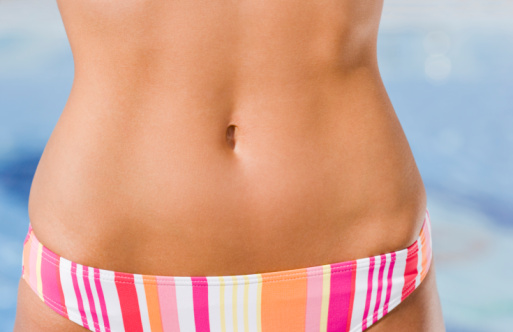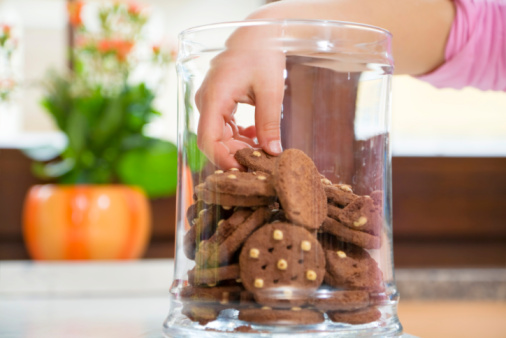Fitting into your favorite pair of jeans is possible with a few simple tips and tricks!
Scientists call belly fat “subcutaneous,” which just means “under the skin.” But underneath that visible fat often lurks a hidden layer of fat, called visceral fat, made up of active cells that can trigger an inflammatory process in the body. Inflammation has been linked to everything from diabetes to heart disease, cancer and Alzheimer’s disease. So, not only can it be stopping you from buttoning those jeans, it’s also dangerous.
Fortunately, science has discovered many different ways to attack both kinds of fat and blast them away.
Here are seven ways to whittle your waist and get a flat belly:
1. Lose weight with diet and exercise.
When you drop pounds, no matter how you do it, your belly will definitely shrink. But a study at the University of Alabama in Birmingham found that the women participants, who lost an average of 24 pounds lost both visceral and subcutaneous fat. But only those women who kept up their exercise programs after their weight loss—only 40 minutes twice a week—maintained that visceral fat loss while the others experienced a 33 percent increase in this dangerous form of belly fat.
2. Go all out, then rest.
That’s a description of an exercise program called high-intensity interval training, or HIIT for short. Studies at the University of Virginia, Australia, and elsewhere have found that it specifically targets belly fat while helping to preserve muscle. Basically, it’s any high intensity exercise that you do for a certain period of time (even just a minute) then drop the intensity (say for 30 seconds), then repeat. To be considered high intensity, you should be exercising at 80 to 95 percent of your maximum heart rate—the max number of times your heart will beat in a minute “without overexerting yourself,” according to American College of Sports Medicine. Think running or speedwalking rather than jogging.
But, says the ACSM, HIIT can be easily modified for people of all fitness levels and even those with conditions such as obesity and diabetes. You can do high intensity intervals in your water aerobics or spin class, on the elliptical or rowing machine at the gym, or on your daily walk. Bonus: Not only does it provide similar fitness benefits as endurance activities, it actually burns more calories, usually for hours after you exercise. So, calculate 80 to 95 percent of your max heart rate (it varies with age) and wear a heart rate monitor to make sure you hit the mark. And watch your belly shrink right under your nose. (Always check with your doctor before starting any exercise program.)
3. Cut down on sugar.
It’s not just about the calories. It’s also about cortisol, the chemical your body makes when you’re stressed out. Cortisol contributes to belly fat and, as it turns out, says a 2013 study published in journal Obesity, having high cortisol levels and eating too much sugar magnifies the effect. A similar study published in 2016 confirmed that sugar consumption—in this particular case, sugar-sweetened beverages—is linked to more visceral belly fat and higher levels of cortisol.
4. Speed up the crunches.
Crunches alone aren’t going to reduce belly fat, particularly the dangerous fat deep under the skin, though doing core exercises can help strengthen those muscles so the fat is reined in a bit. The ab muscles are, after all, like a natural girdle. But a 2008 study in the Journal of Strength and Conditioning Research found that speeding up those crunches (one per second) while still maintaining good form helps activate the muscles that can help tighten up your belly. Talk to your doctor before speed crunching and, if possible, have a skilled trainer check your form.
5. Get out and walk.
All you need is a pair of good sneakers for this one. Researchers at the College of Sports Science at Sungkyunkwan University in Korea provided some of the latest evidence for the benefits of walking to blast belly fat. In their study, published in the Journal of Exercise, Nutrition and Biochemistry, they found that obese menopausal women who participated in a walking program (three days a week, for 50 to 70 minutes, at about two-thirds of their maximum heart rate) significantly reduced both visceral and subcutaneous fat compared to a similar group who remained sedentary. Their fat cells actually shrunk, the researchers reported, and the regular walks appeared to also reduce some symptoms of a prediabetic condition called insulin resistance that is characterized by, among other things, a large waist size and elevated blood sugar.
6. Sleep!
Like too much sugar, too little sleep can nudge your production of cortisol, the stress hormone, which tells the body to accumulate fat around your middle. Cortisol can also trigger cravings for high sugar and high-fat foods, adding insult to injury. Too much sleep has also been linked to belly fat accumulation. A recent study in the journal, SLEEP, found that people sleeping fewer than five hours a night had a 32 percent gain in visceral fat versus a 13 percent gain in people snoozing for six or seven hours a night. Sleeping eight hours was linked to a 22 percent gain in the deadly form of belly fat. Your best belly bet: Stick to six to seven hours of sleep.
7. Relax, chill, find your peaceful place.
You’ve heard it already: Too much of the stress hormone cortisol equals too many inches around your waist. This particular fat storage issue is probably caused in part by the sugar and fat cravings that cortisol brings to the party, but it’s also because the stress hormone tells the body to store fat in your midsection. It sends the signal that you’re in survival mode—it can’t be more specific—so your body stores all your calories as fat in that warehouse you call your waist, where it can be accessed quickly in case of emergency. There’s a sort of logic there we can all appreciate, until it’s time to button our pants. To cut back on cortisol, you need to cut back on your reactions to stress. Among the best ways to do both are by learning to meditate (one study found it cut cortisol by 20 percent over a four-month practice); listening to your favorite playlist (Japanese researchers found that it slashed cortisol by 66 percent), get a massage (it cut cortisol by a third in study participants at the University of Miami), or do something spiritual (University of Mississippi researchers found that church-going slashed cortisol by a quarter).
The post 7 Flat Belly Tips Straight from the Experts appeared first on The Leaf.




Comments
Post a Comment